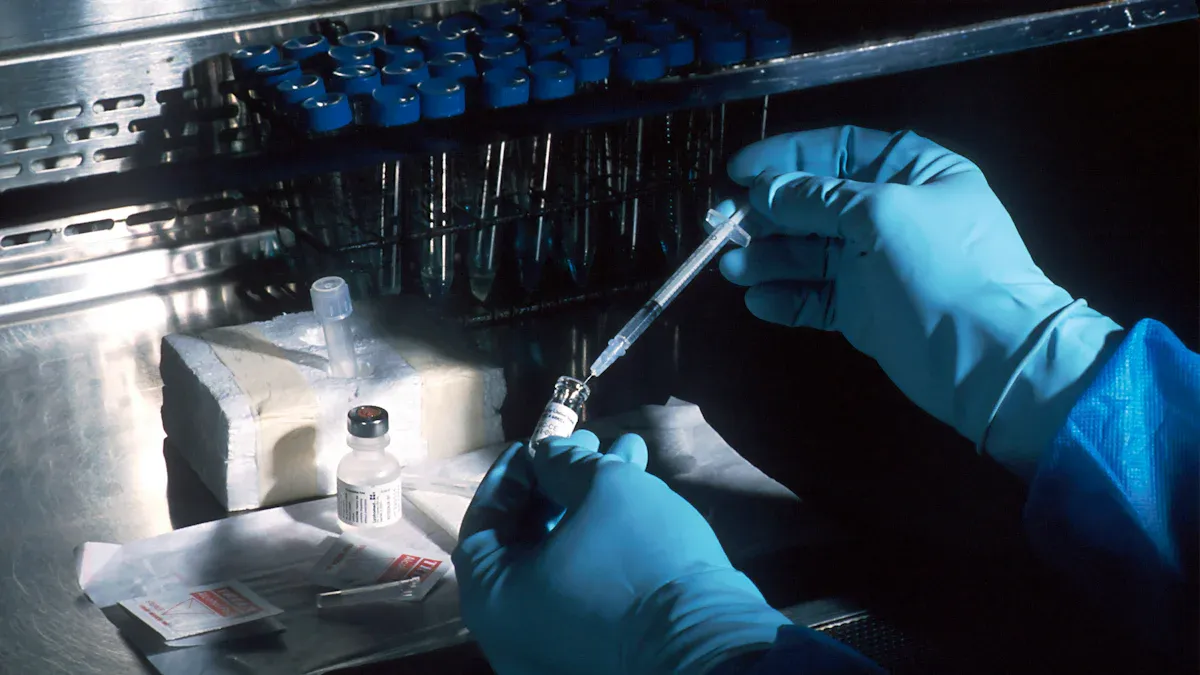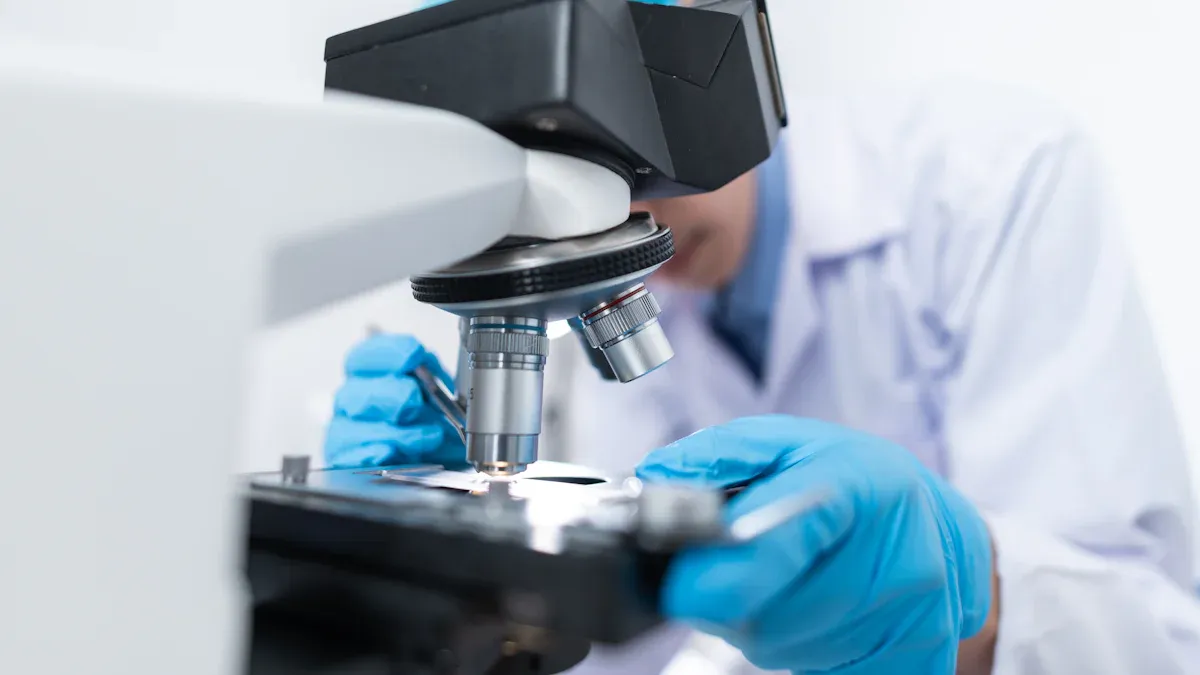
Ultrasonic DNA disruptors, including the DSCIENTZ18-A UITRASONIC DNA BREAKER, have revolutionized biotech research with their precision and efficiency. These devices, such as the UITRASONIC DNA BREAKER, support the global market, valued at $1.2 billion in 2023, by enabling faster genetic analysis, stable marker development, and automated workflows for DNA manipulation.
Key Takeaways
- Ultrasonic DNA disruptors break DNA into smaller pieces. This helps get better sequencing results and more accurate data.
- These tools make breaking cells and getting DNA faster and easier. They give more DNA and save time compared to old methods.
- Ultrasonic methods help deliver genes better. This opens new chances for gene therapy and making new medicines by improving how genes are taken in.
DNA Fragmentation for Sequencing

Importance of DNA fragmentation in sequencing
DNA fragmentation is a critical step in sequencing workflows. It ensures that DNA is broken into smaller, manageable pieces, which are essential for creating libraries compatible with sequencing platforms. Fragmentation directly impacts sequencing quality, as the size and uniformity of DNA fragments influence read accuracy and coverage. For instance, libraries with shorter fragments, such as 350 base pairs for DNA-seq, often yield higher-quality data compared to longer fragments.
The analysis identifies fragment length as a major factor affecting sequencing quality. Libraries with long fragments tend to report lower Phred scores and higher mismatch rates, particularly in paired-end sequencing.
Role of ultrasonic DNA breakers in precise fragmentation
Ultrasonic DNA breakers, such as the Covaris AFA system, have transformed DNA fragmentation by offering unparalleled precision. These devices use acoustic energy to shear DNA into consistent fragment sizes, reducing variability across samples. Unlike traditional enzymatic methods, ultrasonic techniques adapt to various input types and deliver uniform results. This flexibility makes them indispensable in modern sequencing workflows.
A comparison of traditional and ultrasonic methods highlights their advantages and limitations:
| Method Type | Advantages | Disadvantages |
|---|---|---|
| Traditional Enzymatic | - Familiarity in laboratory settings | - Inflexible to different input sample types |
| - Effective for specific applications | - Suboptimal hybrid capture and biased fragmentation affecting results | |
| Ultrasonic (Covaris AFA) | - Consistent fragment sizes across various sample types | - Requires investment in specialized equipment |
| - Significant reduction in duplication rates (20-80%) | - May require training for optimal use | |
| - Threefold improvement in exome enrichment | N/A |
Advantages in next-generation sequencing workflows
Ultrasonic DNA breakers streamline next-generation sequencing (NGS) workflows by minimizing errors and improving efficiency. Statistical analyses reveal a strong correlation between ultrasonic-assisted fragmentation and enhanced sequencing outcomes. These methods reduce duplication rates, improve exome enrichment, and ensure higher pass rates in automated workflows.
For example, Covaris AFA systems demonstrate low discordant rates even with minimal DNA input, outperforming enzymatic fragmentation methods. This reliability makes ultrasonic techniques a preferred choice for high-throughput sequencing projects. By delivering consistent and high-quality results, ultrasonic DNA breakers play a pivotal role in advancing genomic research.
Cell Lysis for DNA Extraction
Ultrasonic DNA breakers in cell lysis
Ultrasonic DNA breakers have become indispensable tools for cell lysis in modern biotech research. These devices utilize high-frequency sound waves to disrupt cell membranes, releasing intracellular components such as DNA, RNA, and proteins. This method is particularly effective for bacterial lysis, where robust cell walls often challenge traditional techniques. Studies highlight that sonication frequently serves as a pre-treatment step, enhancing the efficiency of subsequent extraction methods. By delivering precise and controlled energy, ultrasonic DNA breakers ensure consistent lysis across various cell types, making them a preferred choice in research and pharmaceutical applications.
Efficient DNA extraction using ultrasonic techniques
Ultrasonic techniques significantly improve DNA extraction yields compared to conventional methods. For instance, ultrasonication achieves a cell lysis capability of 106 ± 3%, outperforming heating (68 ± 5%) and freeze-thaw methods (48 ± 15%). Additionally, during bacterial gene quantification, ultrasonication produces over three times the fluorescence signal compared to commercial DNA extraction kits. These results demonstrate the superior efficiency of ultrasonic methods, particularly in high-throughput workflows where consistency and yield are critical. Researchers also benefit from the ability to process diverse sample types with minimal manual intervention.
Benefits over traditional cell lysis methods
Ultrasonic cell lysis offers several advantages over traditional methods like grinding or chemical lysis. It provides precise and effective disruption without damaging sensitive biomolecules, ensuring high-quality DNA for downstream applications. Recent advancements, such as miniaturized and portable ultrasonic devices, further enhance their utility in diverse research settings. Unlike detergents, ultrasonic solutions achieve homogeneity in lysis while maintaining performance across varying cell densities. This robustness and flexibility make ultrasonic DNA breakers essential for applications ranging from drug development to analytical chemistry.
Chromatin Shearing for Epigenetic Studies
Preparing chromatin for epigenetic research
Chromatin shearing is a critical step in epigenetic studies, particularly in techniques like chromatin immunoprecipitation (ChIP). Researchers must fragment chromatin into smaller pieces to isolate specific protein-DNA interactions. This process ensures that the DNA regions bound to proteins remain intact for downstream analysis. Proper chromatin preparation directly impacts the success of epigenetic workflows, as inconsistent shearing can lead to poor enrichment and unreliable results. Ultrasonic DNA breakers provide a reliable solution by delivering controlled energy to achieve uniform chromatin fragmentation, even in challenging sample types.
Ultrasonic DNA breakers in ChIP-seq workflows
ChIP-seq workflows demand precise chromatin shearing to identify protein-binding sites across the genome. Ultrasonic DNA breakers, such as the Bioruptor XL sonicator, excel in this application by offering adjustable pulse settings and sample rotation mechanisms. These features ensure consistent shearing across multiple samples, reducing variability and enhancing reproducibility. For example, studies have shown that optimal conditions, including 500 μL sample volumes and rotating carousels, significantly improve sonication efficiency. This level of precision makes ultrasonic devices indispensable for high-throughput ChIP-seq experiments, where accuracy and consistency are paramount.
Consistency and precision in chromatin shearing
Ultrasonic DNA breakers deliver unmatched precision in chromatin shearing by allowing researchers to control key parameters like sample volume and sonication pulses. The Bioruptor XL system demonstrated that precise adjustments to these factors enhance overall shearing efficiency, ensuring uniform fragment sizes. This consistency minimizes experimental errors and improves data quality in epigenetic studies. By leveraging ultrasonic technology, researchers can achieve reproducible results across diverse sample types, advancing the reliability of chromatin-based assays.
RNA and Protein Isolation
Role of ultrasonic DNA breakers in RNA isolation
Ultrasonic DNA breakers play a pivotal role in RNA isolation by efficiently disrupting cell membranes and releasing intracellular RNA. This method ensures the preservation of RNA integrity, which is crucial for downstream applications like transcriptomics and gene expression analysis. Unlike chemical or enzymatic approaches, ultrasonic techniques minimize contamination risks and reduce processing time. Researchers often rely on these devices to handle challenging samples, such as plant tissues or bacterial cells, where traditional methods may fall short. The precision of ultrasonic DNA breakers allows for consistent RNA yields, even in high-throughput workflows.
Protein extraction for molecular biology research
Protein extraction is a fundamental step in molecular biology research, and ultrasonic-assisted techniques have significantly improved its efficiency. By applying controlled acoustic energy, ultrasonic DNA breakers facilitate the release of proteins from cells without compromising their structure or function. Studies have demonstrated the effectiveness of this approach across various sample types. For instance, Jain and Anal reported a statistically significant increase in protein yield (p ≤ 0.05) using ultrasonic-assisted extraction. Similarly, Choi et al. observed the highest protein yield within just five minutes of sonication. The table below highlights these findings:
| Study | Technique | Yield Increase | Significance |
|---|---|---|---|
| Jain and Anal | Ultrasonic Assisted Extraction | Increased yield of solids | p ≤ 0.05 |
| Petcharat et al. | Ultrasonic Assisted Extraction | Higher yield from frog skin | N/A |
| Choi et al. | Ultrasonic Assisted Extraction | Highest yield at 5 min | p ≤ 0.05 |
These results underscore the reliability of ultrasonic methods in achieving high protein yields, making them indispensable in proteomic studies.
Applications in genomic and proteomic studies
The versatility of ultrasonic DNA breakers extends to both genomic and proteomic research. In genomics, these devices streamline RNA isolation, enabling researchers to study gene expression patterns with greater accuracy. In proteomics, ultrasonic-assisted protein extraction supports the identification and quantification of proteins, advancing our understanding of cellular processes. Their ability to process diverse sample types efficiently makes them a valuable tool in fields like drug discovery, biomarker identification, and personalized medicine. By integrating ultrasonic technology, researchers can achieve reproducible results, accelerating progress in molecular biology.
Nanoparticle-Assisted DNA Delivery

Enhancing DNA delivery with ultrasonic DNA breakers
Ultrasonic DNA breakers have emerged as a transformative tool in nanoparticle-assisted DNA delivery. By leveraging ultrasonic waves, these devices enhance the permeability of cell membranes, facilitating the efficient uptake of genetic material. This process, known as ultrasound-mediated gene delivery (UMGD), has shown remarkable improvements in delivery rates when combined with cationic microbubbles (MBs).
- Cationic MBs outperform neutral MBs in enhancing UMGD efficiency, particularly at lower doses of DNA and MBs.
- Statistical evaluations reveal significant improvements in cell culture (P < 0.001) and in vivo (P < 0.05) experiments.
- Higher doses of MBs may reduce this efficiency advantage, emphasizing the importance of dose optimization.
These findings underscore the potential of ultrasonic DNA breakers to revolutionize gene delivery systems, offering precision and scalability for diverse applications.
Applications in gene therapy and drug development
Ultrasound-targeted gene delivery (UTGD) has opened new avenues in gene therapy and drug development. This technique enhances transfection efficiency by increasing cell membrane permeability, enabling site-specific delivery of genetic materials. In vitro studies demonstrate the successful delivery and expression of therapeutic genes, such as luciferase, using biotinylated nanoparticles.
UTGD also plays a pivotal role in silencing genes associated with drug resistance. For instance, researchers have effectively silenced P-glycoprotein, a key factor in cancer cell resistance, leading to increased cytotoxicity in resistant tumors. These advancements highlight the versatility of ultrasonic-assisted delivery in addressing complex therapeutic challenges.
Potential for advancing therapeutic research
The integration of ultrasonic disruption into therapeutic research has shown immense promise. Focused ultrasound techniques, for example, have successfully disrupted the blood-brain barrier, a major obstacle in treating brain tumors. This innovation has significantly enhanced the delivery of chemotherapy drugs to glioma models, with drug concentrations increasing by 1.6- to 8-fold.
| Study Focus | Improvement in Drug Delivery | Context |
|---|---|---|
| Focused Ultrasound (FUS) | 1.4- to 16.6-fold increase | Enhances drug delivery to healthy brains |
| Glioma Models | 1.6- to 8-fold increase | Improves anticancer therapy concentrations |
| Small Molecules | 4.2-fold increase | More effective delivery than larger molecules |
| Monoclonal Antibodies | 3.6-fold increase | Significant but less effective than small molecules |
By overcoming barriers to drug delivery, ultrasonic techniques, including the use of the ULTRASONIC DNA BREAKER, hold the potential to transform therapeutic research. These advancements pave the way for more effective treatments and larger clinical trials, particularly in oncology and precision medicine.
Ultrasonic DNA disruptors have revolutionized biotech research through applications like DNA fragmentation, cell lysis, chromatin shearing, RNA/protein isolation, and nanoparticle-assisted delivery. These tools enhance precision, efficiency, and scalability in molecular studies. Their transformative impact paves the way for groundbreaking innovations, offering immense potential to advance gene therapy, drug development, and personalized medicine in the future.
FAQ
What makes ultrasonic DNA disruptors better than traditional methods?
Ultrasonic DNA disruptors provide precise control, faster processing, and higher consistency. They outperform traditional methods in efficiency and adaptability across diverse sample types.
Are ultrasonic DNA disruptors suitable for small-scale research labs?
Yes, many ultrasonic DNA disruptors are compact and cost-effective. They cater to small-scale labs while maintaining high performance and reliability.
How do ultrasonic DNA disruptors ensure sample integrity?
These devices use controlled acoustic energy to minimize damage. This ensures biomolecules like DNA, RNA, and proteins remain intact for downstream applications.
Post time: Apr-10-2025





